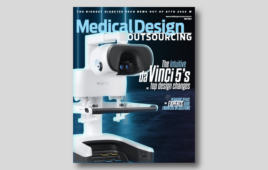
The UCSD wearable cardiac sensor technology. [Image courtesy of David Baillot, Jacobs School of Engineering, UC San Diego]
The device, roughly the size of a postage stamp, features a wear time of up to 24 hours and works during strenuous exercise.
According to the university, the researchers aim to make ultrasound more accessible to a larger population. Sheng Xu, a professor of nanoengineering at UCSD, leads the project. Details of the work done so far published in the Jan. 25 issue of the journal Nature.
“The technology enables anybody to use ultrasound imaging on the go,” Xu said.
Researchers say that, thanks to custom AI algorithms, the device can measure how much blood the heart pumps.
The wearable monitoring system uses ultrasound to continuously capture images of the four chambers of the heart at different angles. It analyzes a clinically relevant subset of the images in real-time using custom-built AI technology.
“The increasing risk of heart diseases calls for more advanced and inclusive monitoring procedures,” Xu said. “By providing patients and doctors with more thorough details, continuous and real-time cardiac image monitoring is poised to fundamentally optimize and reshape the paradigm of cardiac diagnoses.”
According to Ph.D. student Hao Huang, a member of Xu’s group at UCSD, the system minimizes patient discomfort. Huang said it also overcomes limitations of noninvasive technologies like CT and PET, which may expose patients to radiation.
More about the UCSD device
The design of the device allows for attachment to the chest with minimal constraint to the user’s movement. It gathers information through a wearable patch “as soft as human skin,” researchers say, designed for optimal adherence. The system sends and receives ultrasound waves used to generate a constant stream of images of the structure of the heart in real time.
Researchers say the system can examine the left ventricle of the heart in separate bi-plane views using ultrasound. The team developed an algorithm to facilitate continuous, AI-assisted automatic processing.
“A deep learning model automatically segments the shape of the left ventricle from the continuous image recording, extracting its volume frame-by-frame and yielding waveforms to measure stroke volume, cardiac output and ejection fraction,” said Mohan Li, a master’s student in the Xu group at UCSD.
The technology can generate curves to provide accurate and continuous waveforms of key cardiac indices in different physical states. Its AI component processes the continuous stream of images to generate numbers and curves.
“Specifically, the AI component involves a deep learning model for image segmentation, an algorithm for heart volume calculation, and a data imputation algorithm,” said Ruixiang Qi, a master’s student in the Xu group at UCSD. “We use this machine learning model to calculate the heart volume based on the shape and area of the left ventricle segmentation. The imaging-segmentation deep learning model is the first to be functionalized in wearable ultrasound devices.
The current iteration of the patch connects through cables to a computer. Then, the computer can download data automatically while the user wears the patch. The team also developed a wireless circuit for the patch. Xu intends to commercialize the technology through Softsonics, a company spun out of UCSD that he co-founded.




